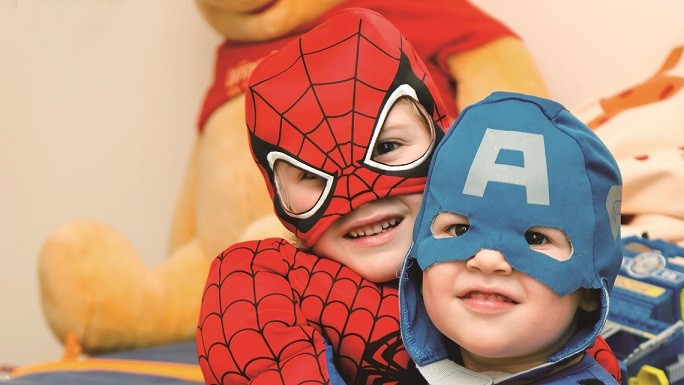
‘Who am I?’ ‘Where do I belong?’ ‘How do I impact on the world around me?’
Today our children are faced with ever-changing circumstances; families with different dynamics, movement in localities, evolving friendships, political and economic instability across the world. Coinciding with the impact of social media and technology on our lives, these ongoing changes greatly influence a child’s sense of identity.
It is increasingly vital that children develop adaptability to change whilst holding onto a sense of self and community. Children develop a sense of personal identity through their relationships with others, their environment and the opportunities they have to learn.
Children who foster a greater sense of self-worth and self-confidence, are more likely to embrace the diversity and challenges of the world, rather than feeling lost and retreating in fear of change and difference. A strong identity helps children to understand that they don’t need to compare themselves with others. They demonstrate an awareness of their strengths, limitations and aptitude, which leads to a greater sense of wellbeing and autonomy, and as such are able to make healthy lifestyle and friendship choices best suited to their own personality. Children who possess a positive sense of identity are also more likely to succeed in school, thanks to a feeling of authenticity that one can be themselves in the face of future obstacles and challenges.
Childhood is one of the most important periods when it comes to shaping one’s identity and part of this comes down to parental influence. The two essential factors that parents contribute in developing a strong positive identity are security and automony. Security in the sense that children feel safe in their environment, and trust in the predictability of those they are closest to, and autonomy in the sense that parents provide opportunity for children to make choices, mistakes, and decisions for themselves.
But beyond the main core of parenting responsibilites, what else can we be doing to help our children foster a greater sense of self?

Communication
A child needs to feel valued in order to build a sense of identity.
• When your child makes any attempts to communicate with you, acknowledge their feelings and ideas without judgement. This ensures they feel a sense of safety and belonging. A mistake often made by parents and teachers alike is to purely praise product and not process. We should be praising children’s efforts and the journey they have taken in their experiences rather than just the outcome.
• Be specific in your communication. Rather than ‘What a nice painting!’ try using ‘I like the way you used this technique’. This extends their understanding of the learning process. Other questions could include:
• How did you create this?
• What is the inspiration behind this? Was it the trip we took to _____?
• What difficulties did you face? How did you find a way past them?
• What would you do differently next time?
Making choices and taking risks
Children are co-creators in their identity, along with the people around them. The ability to make choices and decisions creates a feeling of agency. They are able to find value and autonomy in their decision making, understanding how their actions impact on the people and the world around them. Risk-taking is central to fostering autonomy.
Children need to be provided with opportunities to take risks in their learning, to make mistakes and build resilience through challenges. Play based activities which provide open-ended opportunities for learning are most valuable. For example, constructing a ramp out of cardboard, or an animal from a piece of paper, allows for risk-taking and mistakes to be made, encouraging creative thinking and innovation through different attempts in learning.
Friendships
Fostering positive relationships with peers is an important factor in children’s identity formation. Those who are victims of bullying are less likely to develop the skills described above. Parents can aid their child in developing quality relationships with their peers through opportunities for play. Encourage them to reflect on their friendships, develop tools for conflict resolution and be inclusive in the friendships they form. Opportunities for building friendships outside of the school environment don’t have to be grand displays. A walk in the park with a few friends will build more authentic bonds than an expensive birthday party with 30 children. Social skills, communication and emotional intelligence will thrive in more meaningful interactions.
Celebrating your culture
Children in the Primary Years will begin to compare themselves to others, identifying differences in the way they look and finding familiarity in children that look like them. However, some children can reject their own national identities through the experiences they come across at school. For example, it can be common in schools to enforce the use of English, which can result in children rejecting their mother-tongue and engage more readily in English communication. However, research shows that it is vital for children to gain confidence communicating ideas in their native language before they can communicate in another. It is essential that parents celebrate their cultural background. Communicate to your child that differences are valued and make your child unique.

Exposing children to different perspectives
Children develop a sense of themselves through the stories they read, images, food, games and television. If they are exposed to singular ideas of what children should be, they will often adopt this view. Stereotyping girls favouring pink, boys only playing football, or success measured by monetary outcomes continues to be common. Chimamanda Ngozi Adichie’s well-known TedTalk ‘The Danger of a Single Story’ teaches us about the dangers of such narratives. Those ideas which promote homogenous stereotypes and nationalise people. When choosing reading materials with your child, look at stories from around the world and from the child’s perspective. Choose stimuli that go against the old-fashioned stereotypes and reflect a more balanced, forward thinking notion of what all children are able to achieve.
Engaging with school life
Respecting the views and identities of those around us helps children to form more positive ideas about themselves and respect the identities of others. Language days and cultural celebrations in school are one way to engage with others from a different culture, but these experiences are usually few and far between; providing just a glimpse of different identities and perspectives. Thankfully though, these experiences have the potential to be integrated into multiple aspects of your child’s daily life.
If your child’s school has opportunities to engage in multicultural activities and you as a parent have the time to volunteer, consider running an after-school activity. This could be a book club engaging with stories from different cultures, or a cooking club with food around the world. You may be able to support children in class who require support in their home language, or even provide support for training teachers in another language. This meaningful connection between schools and families should ideally always be encouraged as it will enrich the children’s experiences and help them build a sense of identity by witnessing the adults in their lives building those bridges too.
Take inspiration
Over the last decade, with the aid of social media, there has been a growing number of inspirational young people having their voice heard. At fifteen years old, Greta Thunberg stood up to the lack of government action on climate change, organising a protest outside the Swedish parliament. Within days this became a global movement. Thunberg has since spoken at the United Nations Climate Change Conference and impacted on a young generation across the world. Malala Yousafzai, inspired to promote access to education endured an attempted assassination. She used her resilience and sense of identity in light of these challenges, founded her own non-profit, co-authored the international best-seller I am Malala and received several recognitions for her activism including at the age of 17, being the youngest recipient of the Nobel Prize laureate.
The stories of these young women can be used as role models to help inspire your own children. Expose them to their stories through books, videos and newspaper articles. It shows that there is no limit to what the younger generation can achieve. Our role as the adults in children’s lives is to encourage and facilitate them in developing their voice, and to provide them with a positive platform whereby they can share it.
Identity is not just another word to throw around in educational discourse, it is a child’s right; stated so in the UN Convention on the Rights of the Child (1989). Children in their own right are valued members of society, who not only contribute to it but also help to shape the world and others around them. To support this, we must be objective to the experiences our children are exposed to, ensuring we are role models in embracing the opportunities our complex and wonderful world has to offer.
Let’s not limit our children in their potential. Let’s move beyond the question ,‘What do you want to be when you grow up?’ towards ‘What would you like to change about the world?’ and ‘How are you going to achieve it?’ It is with this support that we are sure to witness the great things that our children can and will achieve in the future.